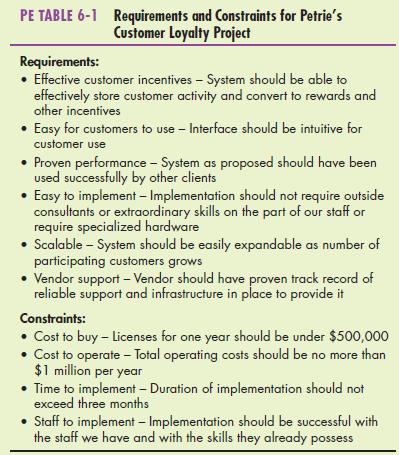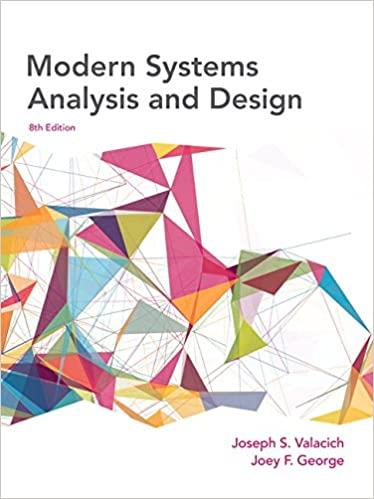Jim Watanabe, the project manager, thought that although the customer loyalty project at Petrie Electronics had gone
Question:
Jim Watanabe, the project manager, thought that although the customer loyalty project at Petrie Electronics had gone slowly at first, the past few weeks had been fastpaced and busy. He spent much of his time planning and conducting interviews with key stakeholders inside the company. He also worked with the marketing group to put together some focus groups made up of loyal customers, to get some ideas about what they would value in a customer loyalty program. Jim had also spent some time studying customer loyalty programs at other big retail chains and those in other industries as well, such as the airlines, which are known for their extensive customer loyalty programs. As project manager, he also supervised the efforts of his team members. Together, they collected a great deal of data. Jim had just finished creating a highlevel summary of the information into a table he could send to his team members (PE Table 6-1).

From the list of requirements, it was clear that he and his team did not favor building a system from scratch inhouse. Jim was glad that the team felt that way. Not only was building a system like this in-house an antiquated practice, it was expensive and time consuming. As nice as it might have been to develop a unique system just for Petrie, there was little point in reinventing the wheel. The IT staff would customize the system interface, and there would be lots of work for Sanjay’s staff in integrating the new system and its related components with Petrie’s existing systems, but the core of the system would have already been developed by someone else.
Just as he was finishing the e-mail he would send to his team about the new system’s requirements and constraints, he received a new message from Sanjay. He had asked Sanjay to take the lead in scouting out existing customer loyalty systems that Petrie could license. Sanjay conducted a preliminary investigation that was now complete.
His e-mail contained the descriptions of three of the systems he found and studied (PE Table 6-2). Obviously, Jim and his team would need to have a lot more information about these alternatives, but Jim was intrigued by the possibilities. He sent a reply to Sanjay, asking him to pass the alternatives on to the team and to prepare a briefing for the team that would include more detailed information about each alternative.
Pe Table 6-2 alternatives for Petrie’s Customer loyalty Project
Alternative A:
Data warehousing-centered system designed and licensed by Standard Basic Systems Inc. (SBSI). The data warehousing tools at the heart of the system were designed and developed by SBSI and work with standard relational DBMS and relational/ OO hybrid DBMS. The SBSI tools and approach have been used for many years and are well known in the industry, but SBSIcertified staff are essential for implementation, operation, and maintenance. The license is relatively expensive. The customer loyalty application using the SBSI data warehousing tools is an established application, used by many retail businesses in other industries.
Alternative B:
Customer Relationship Management-centered system designed and licensed by XRA Corporation. XRA is a pioneer in CRM systems, so its CRM is widely recognized as an industry leader. The system includes tools that support customer loyalty programs. The CRM system itself is large and complex, but pricing in this proposal is based only on modules used for the customer loyalty application.
Alternative C:
Proprietary system designed and licensed by Nova Innovation Group, Inc. The system is relatively new and leading edge, so it has only been implemented in a few sites. The vendor is truly innovative but small and inexperienced. The customer interface, designed for a standard web browser, is stunning in its design and is extremely easy for customers to use to check on their loyalty program status. The software runs remotely, in the “cloud,” and data related to the customer loyalty program would be stored in the cloud too.
Case Questions
1. What do you think are the sources of the information Jim and his team collected? How do you think they collected all of that information?
2. Examine PE Table 6-1. Are there any requirements or constraints that you can think of that were overlooked? List them.
3. If you were looking for alternative approaches for Petrie’s customer loyalty program, where would you look for information? Where would you start? How would you know when you were done?
4. Using the web, find three customizable customer loyalty program systems being sold by vendors. Create a table like PE Table 6-2 that compares them.
5. Why shouldn’t Petrie’s staff build their own unique system in-house?
Step by Step Answer:

Modern Systems Analysis And Design
ISBN: 9780134204925
8th Edition
Authors: Joseph Valacich, Joey George





